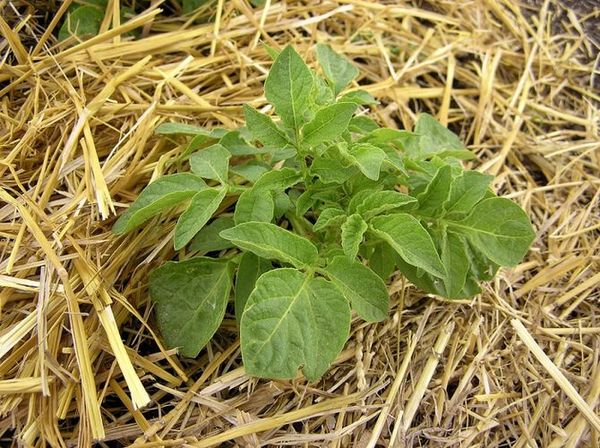A key factor for high potato yields is systematic watering during the growing season. It is important to keep the soil evenly moist from the moment of emergence until the end of the season. Do not allow it to dry completely, which can lead to unintended re-growth during watering and the growth of tuber growth. Consider what temperature can withstand the potato and the subtleties of mulching.
Culture prefers cool, but frost-free conditions. The ideal temperature for growing a product, depending on the stages of the growing season, is as in spring: 8-25 ° C.
Table of contents
- Temperature conditions
- Mulching potatoes
- Watering potatoes
- Irrigation features
- Do I need to water the potatoes when planting
- When to water after planting
- Irrigation rules for good harvest
- How often potatoes are watered in open ground
- Watering in the heat: how often you need to water
- How to water so that the tubers do not cover scab and other ailments
- How many times to water potatoes per season
- How to understand that you need watering
- Signs of excess and lack of moisture
Temperature conditions
The origin of culture from mountain regions with a cool climate has implications for the agrometeorological responses of culture. Climatic features, physiological environment extremely important for the production of high yields with good quality of tubers, in conditions characteristic for each specific site.
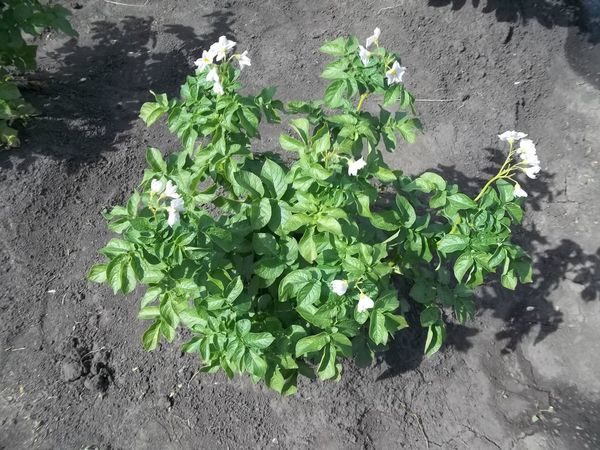
Potatoes have a fibrous root system, at best no more than 60 cm deep. As a result, a plant often cannot take full advantage of nutrients and moisture within the soil profile.
What is the temperature above zero can withstand potatoes
It is best to plant when the soil temperature is 7-10 ° C, daytime is in the range of 18 ° C, night - 12-18 ° C. Optimal soil condition for root growth - from 10 to 35 ° C, the most active development occurs at 15 -20 ° C. Conditions are similar for the development of stolons.
To grow tops- from 7 to 30 ° C, the best mode — from 20 to 25 ° C. The appearance of tubers is caused by a short photoperiod and includes growth hormones. The cooler the temperature of the soil, from 15 to 20 ° C, the faster the tubers are formed and in larger quantities.
The process is favored by a low nitrogen level and a high sucrose level in the plant. High temperatures (35-40 ° C) reduce and actually stop the formation of tubers. Also, the long duration of the day delays the beginning of the development of tubers.
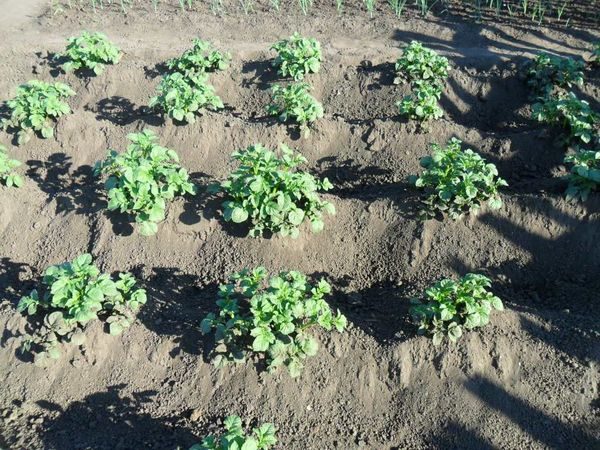
- At 9 ° C there is a slight elongation of seedlings, very slow - at 6 ° C.
- When the temperature is below 6 ° C, the development practically stops.
- The presence of tubers in the soil at 1-2 ° C for several days leads to serious damage that affects the normal growth of the plant.
Potatoes prefers well-drained fertile soil with a high content of organic matter, with an acidity level of 5.0 to 5.5. As the soil becomes more alkaline, the size of the crop increases, but the incidence of scabs also increases - a condition that affects the skin, but not the nutritional value of the product.
The best for harvesting and processing of tubers are temperatures from 12 to 18 ° C. Under cold and heat stress, when below 5 ° C and more than 25 ° C, they are susceptible to diseases, the risk of microbial rot.
What is the storage temperature
The storage area for potatoes must meet the temperature conditions in order for the product to remain healthy and the natural decomposition process to slow down.
It is extremely important that it is dark, well ventilated, for long-term storage of seed varieties maintained around 4 ° C.
For short-term storage, followed by cooking, preferably a medium in which 7-10 ° C.
Storage for a long time at temperatures below 4 ° C turns potato starch into sugar, which changes the taste and culinary qualities. It takes on a bitter taste and the cause of this phenomenon is an enzyme called invertase.
To maintain a low sugar content in tubers, the culture is stored at intermediate temperatures of 8-12 ° C, although there is a risk of tuber germination.
Potatoes are stored in an adequate environment in commercial warehouses for ten to twelve months. At home the term is only a few weeks. If green areas containing glycoalkaloids are formed on the tubers, they must be trimmed before using the product.
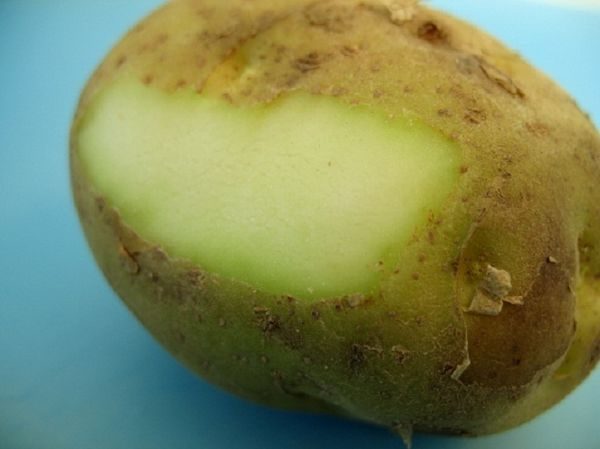
How to store in a vegetable store, cellar, refrigerator
Optimum conditions of temperature, humidity, aeration, degree of oxidation are the most important factors for the storage of potatoes. Being a living organism, its quality decreases due to the loss of moisture and physiological decay. Impairments are directly related to storage temperature.
Vegetable store
Before being placed in storage, the tubers must be cured at a temperature of 7-15 ° C and a relative humidity of 85-95% within two weeks. During the curing process, skin thickening and healing of small cuts occur, which minimizes the penetration of pathogens.
Most pathogens transported to the storage with tubers logarithmically increase population growth at 5-26 ° C.
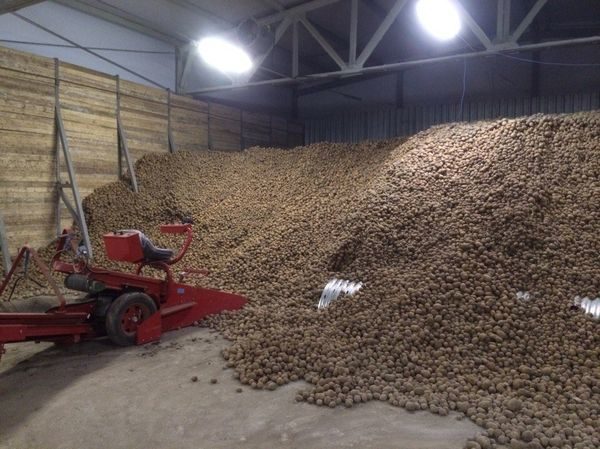
- Store potatoes in a dark place at 4-8 ° C and humidity of 80-90%. Although it loses moisture due to breathing, low humidity is the main cause of shrinkage during storage. In good conditions, the product lasts up to six months.
- At temperatures above 8 ° C, tubers germinate in two to three months.
- When stored with temperature below 4 ° C Potato gets a sweet taste. But normal taste can be restored if left for several days, before use, at room temperature.
Do not allow the freezing of potatoes.
Cellar
In most modern houses there are several places with good conditions for storing vegetables. The ideal place is the cellar in which the tubers are stacked in heaps. It is better to store in several small heaps.
In potatoes piled up, the lower layer is often damaged due to the weight of the upper layers. In addition, the ventilation does not reach the center, and the product is very hot, which reduces the quality and reduces the shelf life.
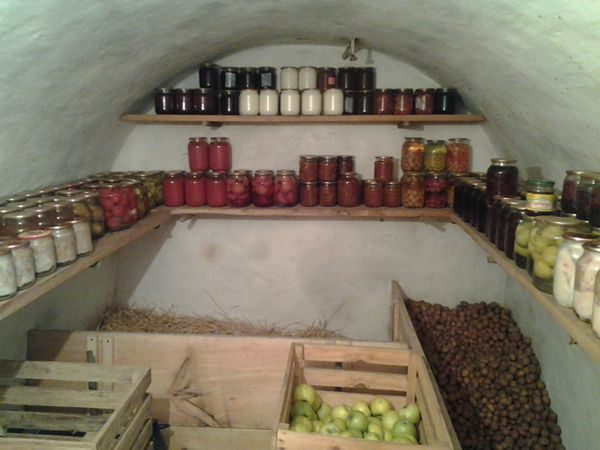
Can fold the tubers into small plastic bucketsthat cover with a layer of wet sand, boxes or baskets. Paper or perforated bags work well. The use of shelves on which containers with tubers are stacked provides good air circulation.
Fridge
Storage in the refrigerator (usually at 2-5 ° C) undesirable. Cold temperatures contribute to the conversion of starch into sugar, which leads to a sweetish taste and discoloration of the product during cooking. To weaken this effect will warm the potatoes, before cooking, at room temperature for some time.
Perforated plastic or paper bags in which potatoes are placed provide the environment for extending shelf life in the refrigerator.
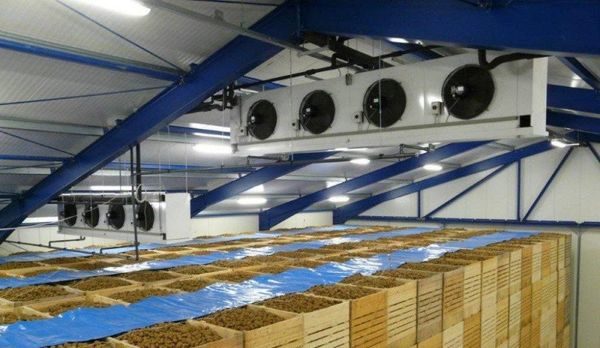
Losses are mainly caused by such processes as respiration, changes in the chemical composition and physical properties of tubers, damage at extreme temperatures.All mentioned losses depend on storage conditions.
Air circulation, the composition of the atmosphere, the relative importance (85-95%) is well controlled in the vegetable store, which is pre-treated with germination inhibitors and equipped with mechanical ventilation.
What minus temperature the culture withstands, and at what freezes
Direct frost damage occurs when ice crystals form inside the protoplasm of plant cells (intracellular freezing). The degree of damage depends mainly on how quickly the temperature drops. At a slower pace, the formation of ice is extracellular, and the plant has a chance to recover.
Saturated vapor pressure over ice is lower than water. As a result of extracellular ice formation, water evaporates, passes through semipermeable cell membranes and precipitates onto ice crystals outside the cells.
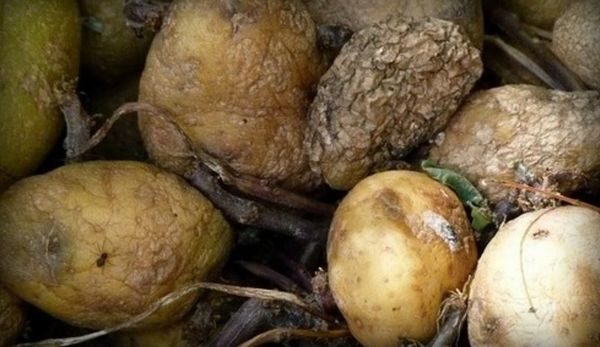
When water is removed from the cells, the concentration of the solute increases, which reduces the chance of freezing. But as the ice continues to grow, the cells dry up more and more.In damaged plants, extracellular ice crystals are much larger than the surrounding dead cells, which causes secondary stress to the surrounding cells.
With prolonged exposure to the freezing effect the plant dies completely. In an adult plant, the processes of biosynthesis (assimilation) stop at 2-4 ° C, as a result of which the tops turn brown. Freezes the plant at minus temperatures of -2 ° C.
The slope of the earth affects the severity of frost. Potatoes growing at high levels experience warmer temperatures and less frost damage. Conversely, planted in a lowland, falls into microclimatic conditions, known as frost pockets, collecting cold air.
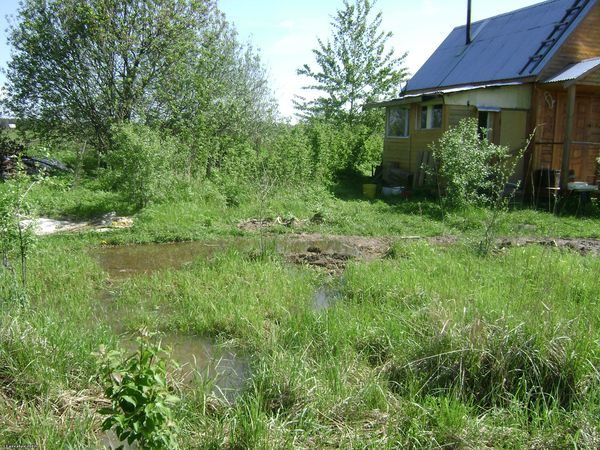
At what temperature in spring will the potatoes in the ground freeze
Potatoes are planted in April, when the ground is thawed, dried and sufficiently heated. When planting in a soil with a temperature of less than 6 ° C, some tubers may rot and die. Unexpected late frosts can damage shootswhen the green foliage turns black. In the ground, potatoes will not suffer, but only if the upper part survives. Early plantations, subjected to long periods of cold weather, die for other reasons:
- cold and wet conditions delay germination and cause seed to grind;
- light frosts, about 0, -2, do little harm to potato plants, but the difference between a light frost and a hard frost is only a few degrees;
- temperatures of -2.5, -3.5 cause serious damage to potatoes.
Mulching potatoes
Potatoes grow best in rich, loose soil. Creating it helps using organic mulch. The reasons for using mulch include retaining moisture in the soil, improving fertility and health, reducing weed growth and increasing the visual appeal of the area.
What are the potato benefits from being under mulch
In hot summer periods, mulching is a factor in plant survival.The practice of mulching has a huge impact on the consistency of soil moisture. Potatoes are particularly susceptible to excessive temperatures and irregular soil moisture.
A good thick layer of organic mulch helps to keep it in optimal condition both in hot and cold weather.
By the beginning of the growing season mulch keeps the soil warmwhich is especially important at night. As the potato grows, it stabilizes the temperature and humidity of the soil, preventing the growth of weeds.
The effect of mulch is complex. It forms a layer between the soil and the atmosphere, preventing the penetration of sunlight to the surface, thereby reducing evaporation. On the other hand, it can prevent water from entering the soil, absorbing it.
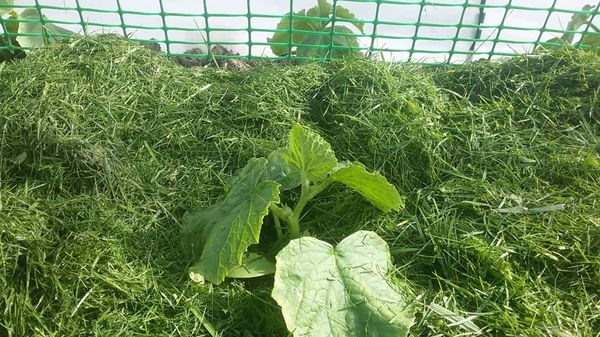
How to plant potatoes under the mulch of cut grass
Cut grass for mulch better to mix with leaves of trees or coarse compost to ensure aeration and decomposition of the material without rotting. Freshly mowed grass can damage a plant; decomposing leads to a destructive accumulation of heat that blocks air and moisture circulation, so it is better to dry it before use.
Comparison of mulch, mowed grass and straw
| Mowed grass | Straw |
| Mixed with dried leaf litter forms good compost with a healthy balance of nutrients (nitrogen, phosphorus and potassium; this dramatically reduces the need for artificial fertilizers). | Controls moisture and reduces high-temperature stresses of the plant, but more vulnerable to frost and wind. |
| Decomposes quickly because of the correct ratio of carbon and nitrogen, which also helps to avoid problems such as mold, the unpleasant smell of rotting. | Controls Weeds, but at the same time there is the likelihood of contamination by seeds (weeds). |
| Fresh grass has a relatively high nitrate content, and most of it returns to the soil. Do not apply too thick layer, as mowed grass decomposes into mucous cellulose, which is very hot and can burn the plant. | Basically carbon. It dries nitrogen from the soil and therefore it should be mixed with grass, manure, compost to minimize losses. |
| Microbes can suck out nitrogen and others soil nutrients in the process of decomposition, for this reason some fertilizer is added to it, compensating for the loss. | The ideal environment for slugs, attracts mice, voles. |
The gain from any mulch is high yields and easier potato harvest.
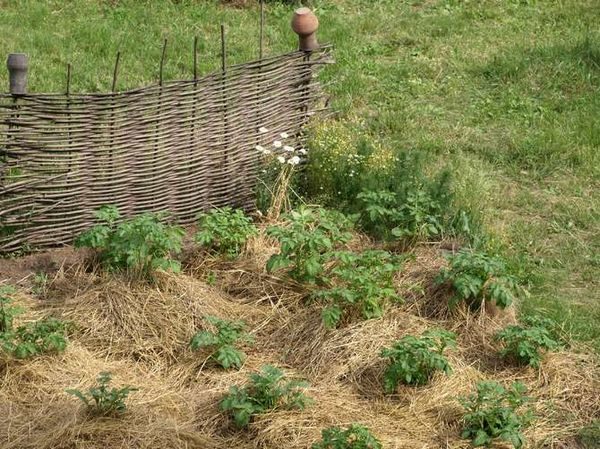
Growing potatoes under mulch
Any biodegradable material works. But the most preferred method for growing high-yield potatoes is freshly cut grass or straw mulch. They keep the soil cool and moist, protecting it from the Colorado potato beetle and other crawling insects.
Potatoes needs a thick layer, unlike other vegetable crops. Every few weeks it is checked for gaps and another layer is added.
To ensure the best results of potato cultivation using mulching, it is necessary:
- Well loosen the soil.
- Prepare an area for landing. Dig a furrow about 10 centimeters deep and 25 cm wide four to six weeks before the last frost.
- Thoroughly mix garden compost (he prevent soil compaction after landing).
- Plant the seed tubers cut side down (or whole) with eyes directed upwards, at a distance of about 30 cm from each other. Whole tubers are pressed into the soil about 8 cm, cut - 2 cm deep.
- Fill the furrow 15 cm with a layer of pure straw.
- When the plant breaks through the covering litter, add another layer 10 cm thick.
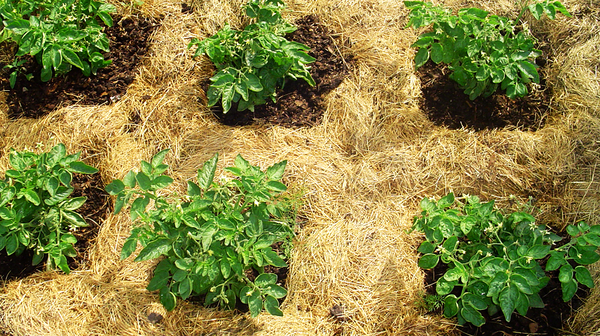
Water as needed, keeping the soil evenly moist, but not moist. At the same time remove the mulch is not necessary.
Watering potatoes
Water is a vital component in potato production, essential for both yield and quality. Irrigation at the beginning of the growing season minimizes common scab, stimulates the growth of the bush, and maximizes the number of tubers.
At the end of the season helps to harvest with minimal losses. But water must be applied in sufficient quantities and at the right time in order to achieve a good harvest.
Irrigation features
Regional climatic conditions, weather, soil conditions affect the choice of planting time.
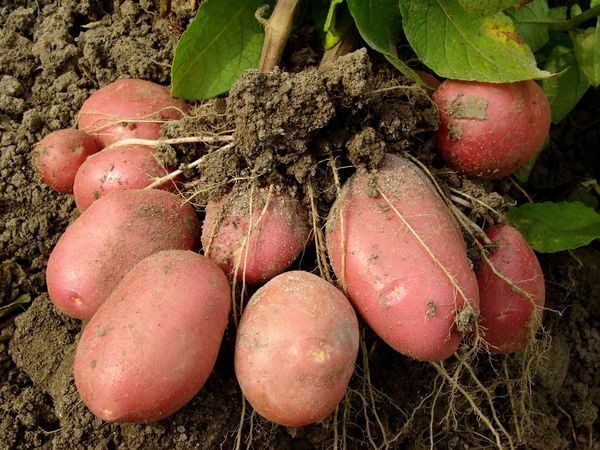
The depth of root formation of potatoes may vary, but the optimum is usually 700 mm. Reduces the ability of the roots to find water in the soil compacted soil, and accordingly affects the recommendations for irrigation planning.
A moderately acidic soil is preferred, but this is not essential, as the potato is adapted to a wide range. Dig a furrow with a depth of 10 centimeters, where the tuber with the buds pointing upwards is placed and covered with soil.
If necessary, you can scatter fertilizer from above. So, when growing potatoes in an alkaline environment, after planting, sulfur is used, which maximizes germination and eliminates common scab.
Do I need to water the potatoes when planting
Potato - moisture-loving culture, but when planting it does not water. It is preferable to plant in an open and well-lit position in a fertile, evenly moist, well-drained soil.
The need for water is provided by the parent tuber. On the contrary, additional watering can cause rot.
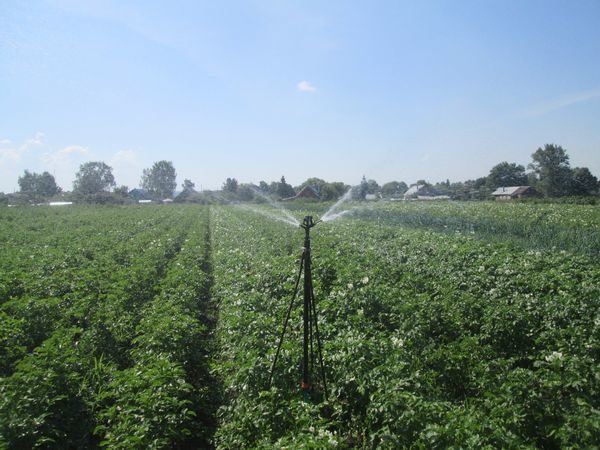
When to water after planting
Potatoes need a stable, seasonal supply of water, but this is important 6-10 weeks after planting, when the crop develops tubers. To supply the culture with water usually begin after germination.
Irrigation rules for good harvest
Reliable watering schedule, cool soil temperatures provide uniformly shaped tubers. Both moisture saturation and lack of water affect the yield, endangering the health of the plant.
The general rules are:
- to water the potatoes once a week, taking into account possible precipitations, with a large amount of water that moisturizes the soil about 30 cm in depth (the minimum consumption is 50 liters per 1 square meter (or about 3-4 liters per bush), but in fact everything depends on the soil characteristics );
- a young plant is watered more often - once in 4-5 days;
- increase the frequencyonce every 2-3 days when the tubers begin to form (this happens almost simultaneously with the flowering of the plant);
- by the end of the growing season, when the tops turn yellow and begin to die, watering is stopped, which will allow the tubers to dry before harvesting.
Irregular watering causes growths and cracks in the tubers. This is due to the fact that, with an insufficient amount of water, they do not develop, but with subsequent abundant irrigation, a second (new) growth occurs.
How often potatoes are watered in open ground
Potatoes need a lot of moisture, especially during the flowering period, when the tubers begin to form. If Mother Nature reluctantly supplies the necessary water, then you may need some type of irrigation system (drip irrigation has a great advantage).
Watering in the heat: how often you need to water
In arid time the plant preferably watered at least once a week. It is better to do this in the evening and in two steps. Occasional abundant watering is sometimes better than insufficient frequent, which moisturizes only the surface layer of the soil, stimulating small rooting.
After watering can loosen the soil. Brings its effect and irrigation.
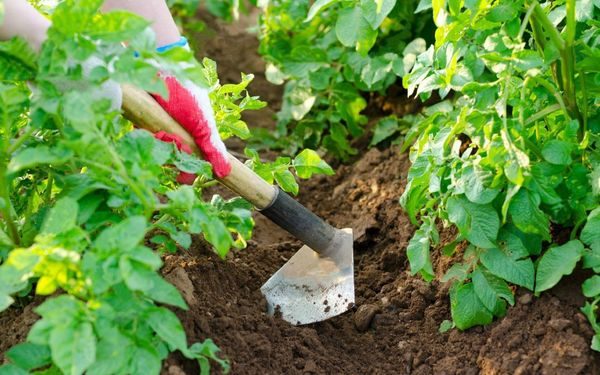
How to water so that the tubers do not cover scab and other ailments
It is preferable to water the plant in the early morning hours. The afternoon sun evaporates water. A plant that remains wet at night is susceptible to disease.
Warm wet foliage encourages the growth of fungi and weakens the structure of the plant as a whole. In addition, watering should be directed to the roots, where it is needed most, and not on the top of the plant.
How many times to water potatoes per season
The need for moisture in April-September varies depending on such factors as climatic conditions and soil type. Watering at certain stages of growth:
- Planting and watering up to 30 days: before the emergence of sprouting, watering is avoided if the soil has dried before planting (you should always consider pre-irrigation). Young plants (after emergence of shoots) receive the first watering in about 5 days.
- 30-60 days: Moisture is critical for vegetative growth and tuber production.
- 60-90 days: correct and careful watering is necessary for the growth of tubers.
- 90-120 days: tops turn yellow and die off. Watering about a week before harvesting can still be continued, but in moderation.
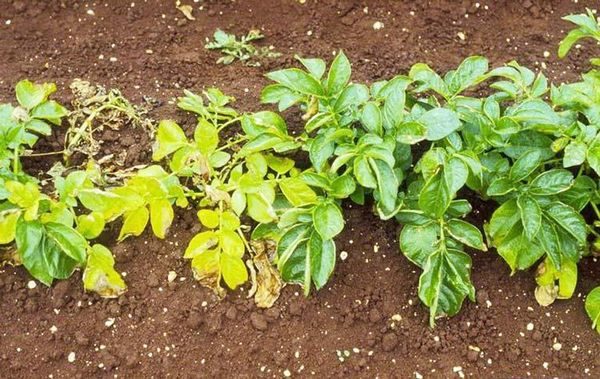
How to understand that you need watering
The rate of absorption of moisture by sowing is very dependent on the weather. Potatoes finely rooted plant, sensitive to even small water deficiencies (in the root zone). Whenever it is exposed to moisture deficiencies, growth rates are reduced.
Soil is stored in water with heavy rainfall after irrigation irrigation. Well-structured porous soil, like loam, is capable of flowing up to 100 mm of water per hour. Compacted heavy soil (clay) is limited to 5 mm per hour.
Signs of excess and lack of moisture
The consequences of the practice of improper watering lead to the fact that the plant is subjected to stress, which lasts several days after the problem is eliminated. Excess moisture contributes to decay, increases the risk of disease. On the contrary, a lack of moisture when the soil dries out completely stops the formation of tubers or leads to the development of various defects.
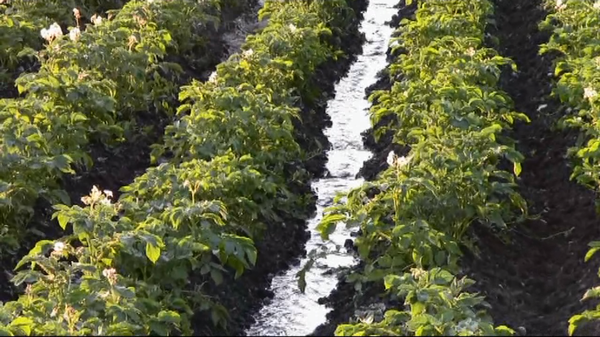
Potatoes - one of the most useful vegetable crops. It grows easily, requires little preparation, a bit of care and even pleasure during the harvest.
